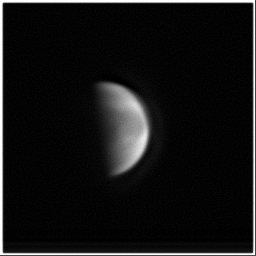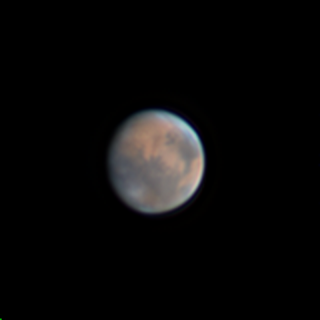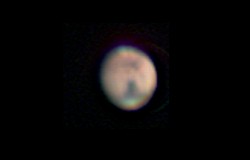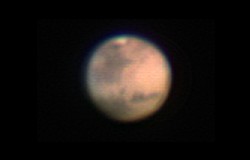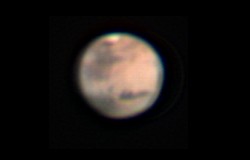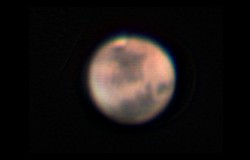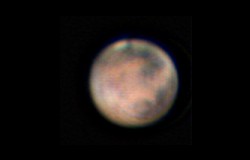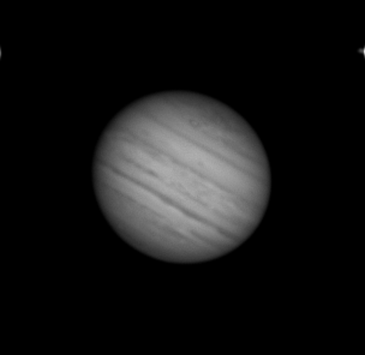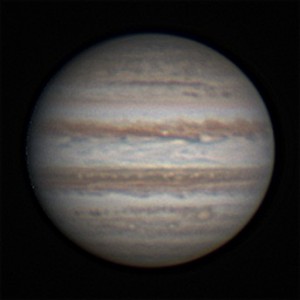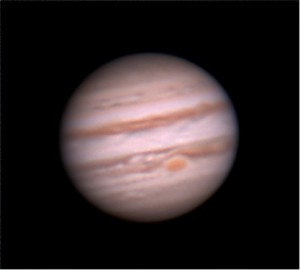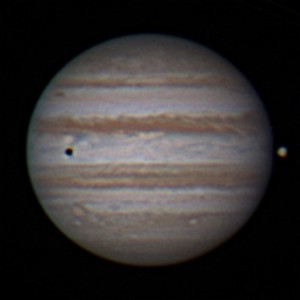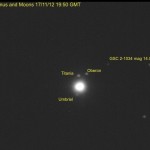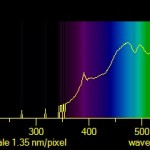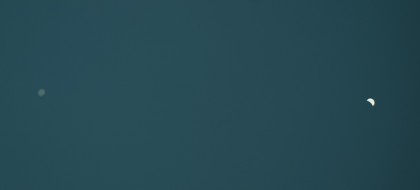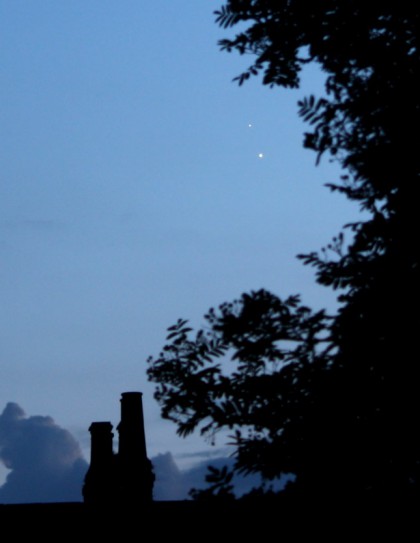Mercury
LX200 at f10 with the ZWO ASI 2900MM and Baader IR pass filter
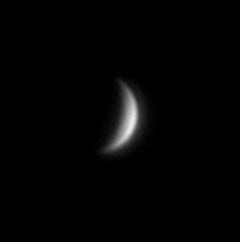
LX200 at f10 with the ZWO ASI 2900MM and Baader IR pass filter. The bright white patch is Kuiper crater.
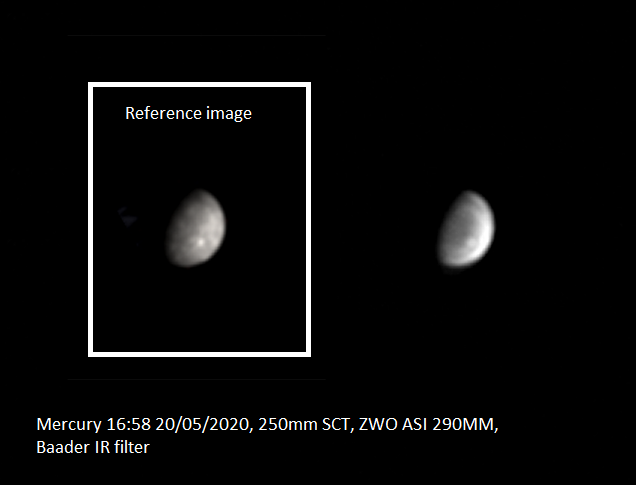
My first attempt at daylight imaging of Mercury. I first centred the scope on the Sun (with a Mylar filter) then used GOTO Mercury. I positioned the observatory roof so the scope was completely in shade, removed the solar filter and Mercury was in the f10 field. I then switched to f20 and started imaging. The IR pass filter certainly seems to help with visibility and seeing. Processing shows that a small number (<1%) of individual frames are very good clearly showing the phase but no real detail due to noise. Finally it has to be said observing on a warm sunny afternoon is great!
The image blow has reference data from the Mercury Messenger spacecraft. I blurred the spacecraft image to match my data and it clearly shows the features seen are real.
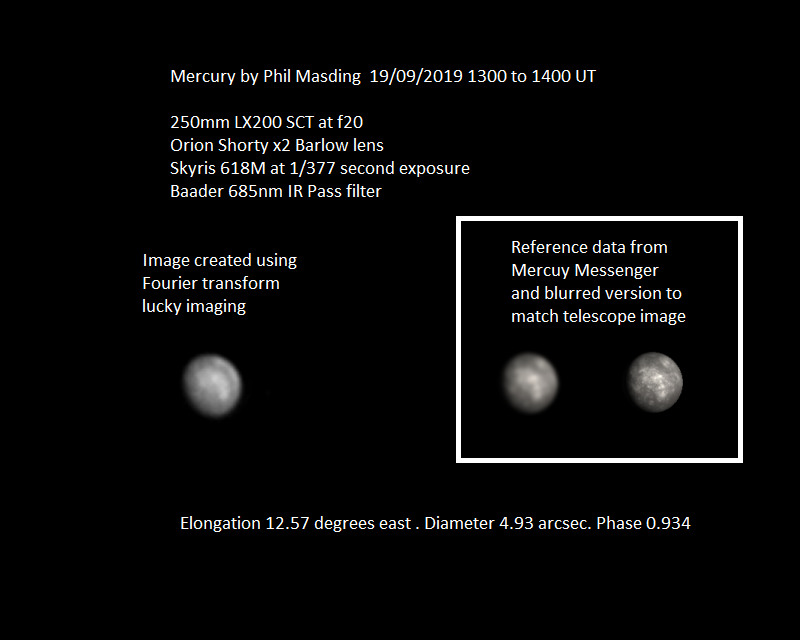
Venus
June 2023
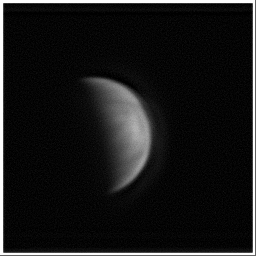
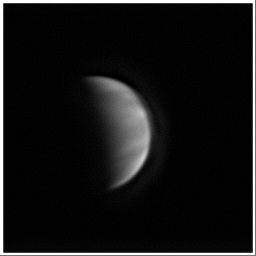
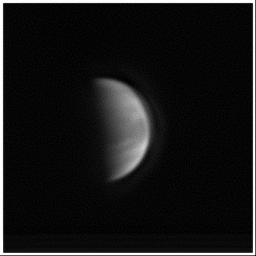
May 2023
Nice detail on Venus on 27/05/2023
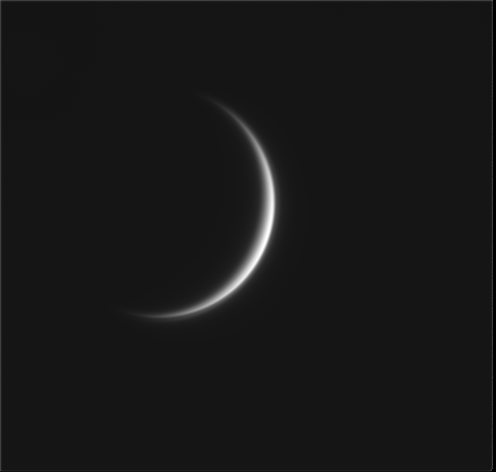
This was an attempt to allow more detail to be seen at the terminator. Diving by IR should cancel out part of the brightness gradient from limb to terminator.
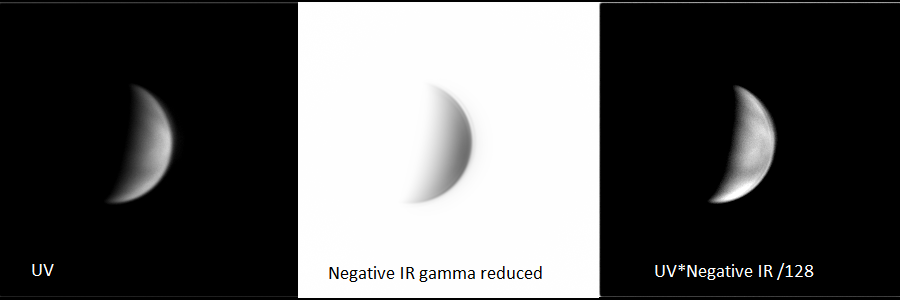
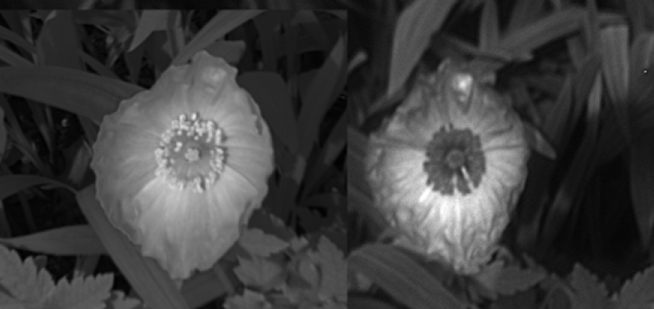
Venus at 18:53 on 08/04/2020
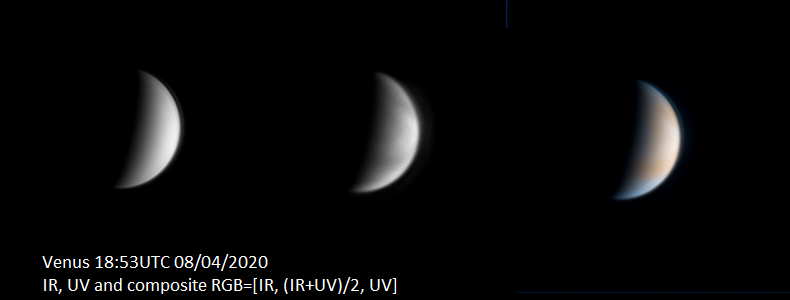
Venus at 18:45 on 06/04/2020
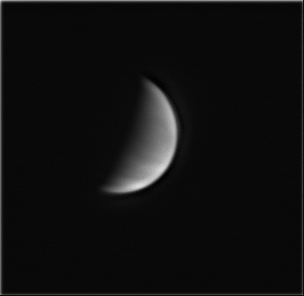
Venus passes through the Pleiades on 04/04/2020. Canon 450D at 55mm, 20 secs, ASA400
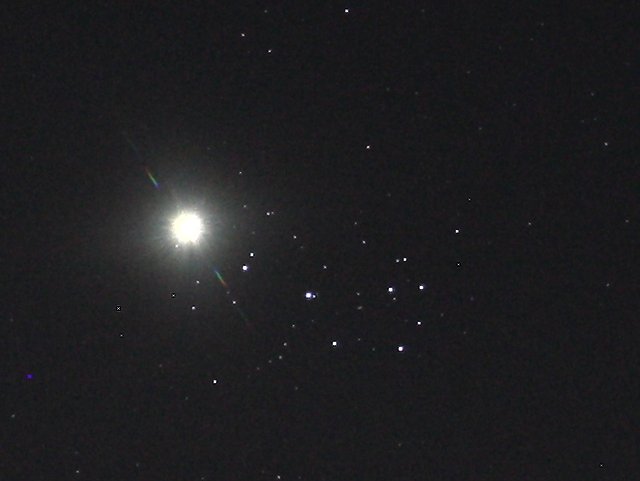
Venus and the Moon 26/30/2020. Venus UV image 10″LX200 SCT at f10 and ZWO ASI 290MM. Wide field Canon 450D at 55mm.
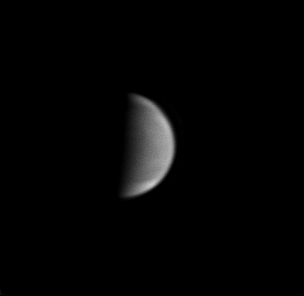
Venus in UV with a new ZWO ASI 290MM camera.

June 2018
Venus in broad daylight. On 30/06/2018 the sky seemed particularly clear and blue. With the telescope as a guide I was easily able to see Venus with the naked eye at 16:00UTC when the Sun was still 30 degrees above the horizon. This shot with the Canon 450D at 55mm gives a good impression of how it looked.
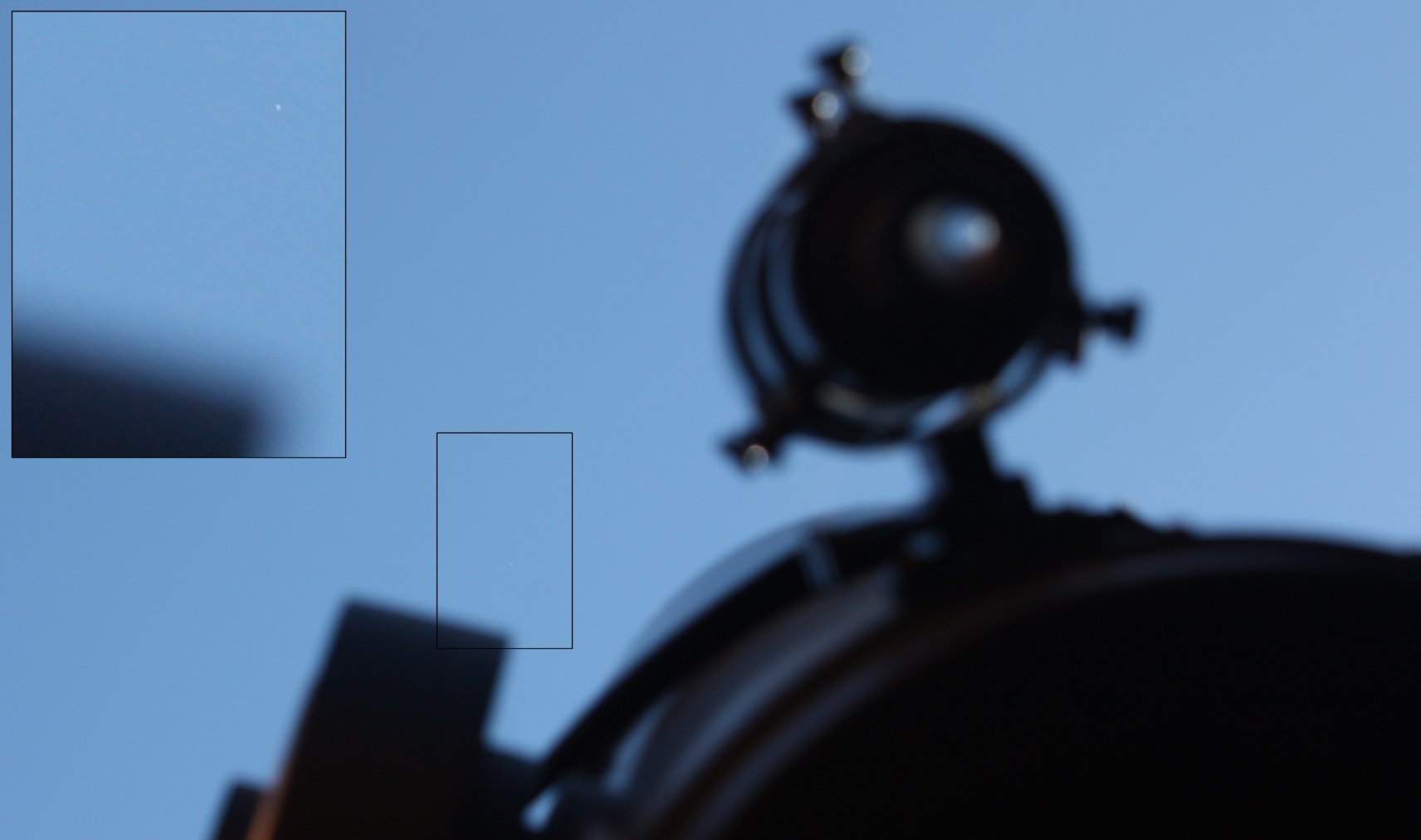
Mars
January 2023
Mars at about 19:00 on 21/01/2023. ASI290MM RGB filters and 250mm SCT. Nice cloud structures over the north pole.
Occultation by the moon 08/12/2022. Cloud arrived with about 10 minutes to go to the occultation but was thin enough to salvage something.
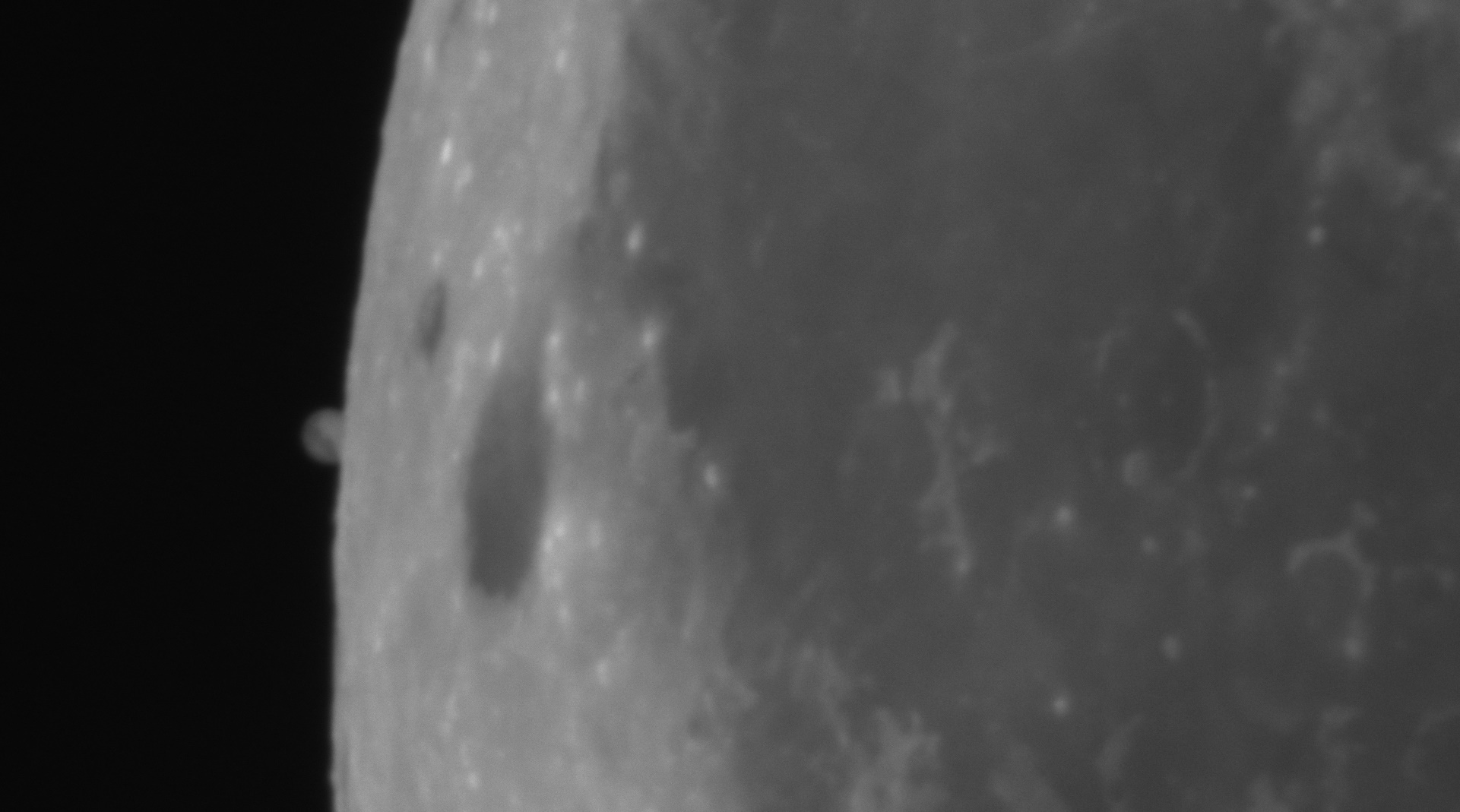
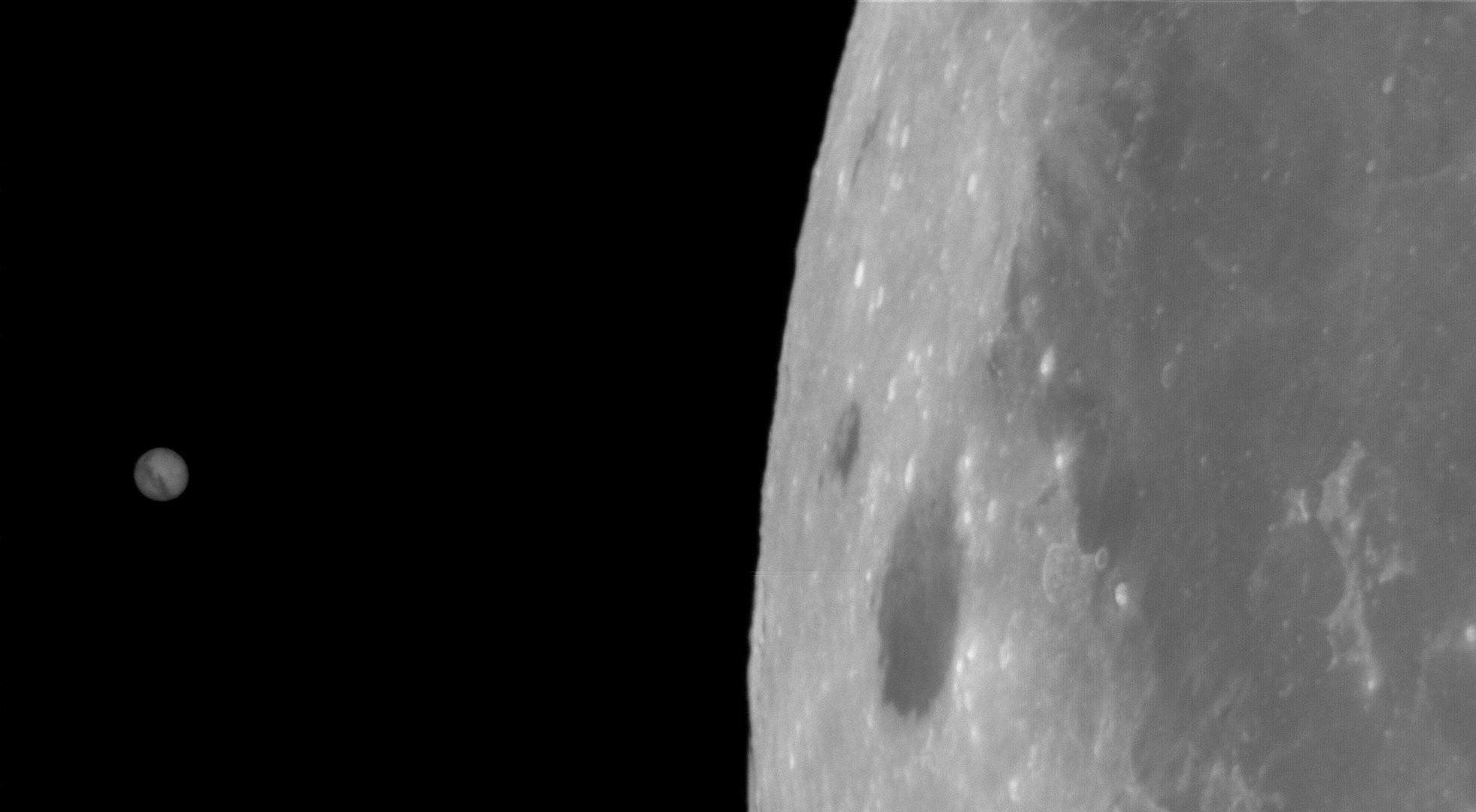
An IR view from 27/11/2020 with a noticeable phase again now.
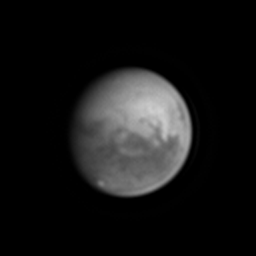
A first look at Syrtis Major since August
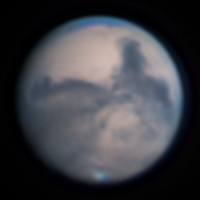
October 2020
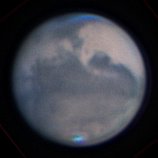
Mars again using IR-RGB. 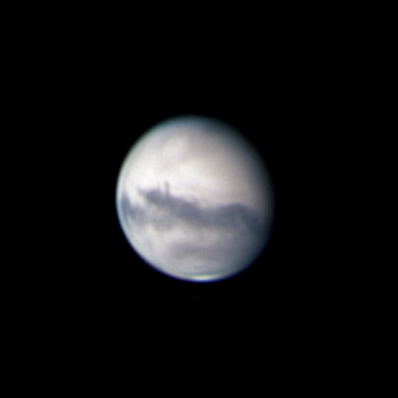 Mars 20200905 02:31
Mars 20200905 02:31
August 2020
Also Mars near the Pleiades with the Canon 450D and a 250mm lens. Single 1 minute exposure at ASA800
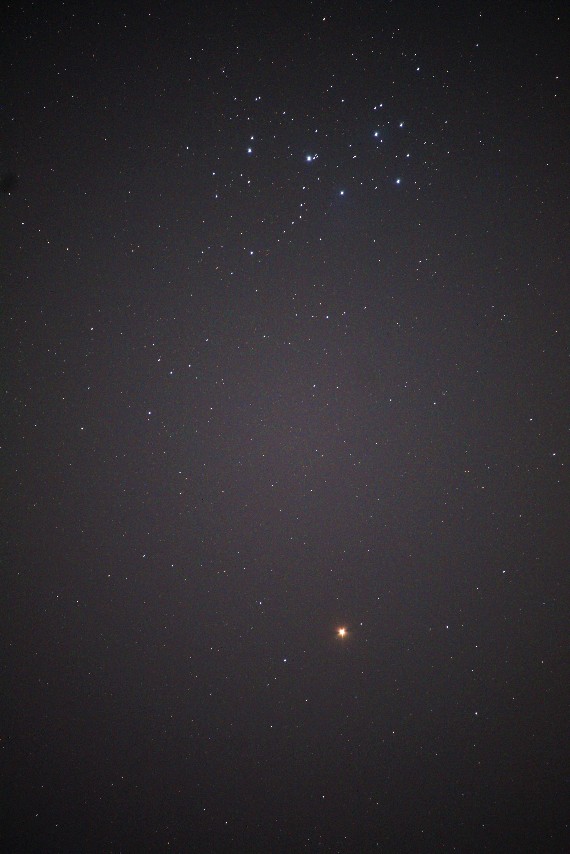
Mars
More Mars images using same set up as before. Slightly better resolution this time. A lot colder though, it felt like Autumn.
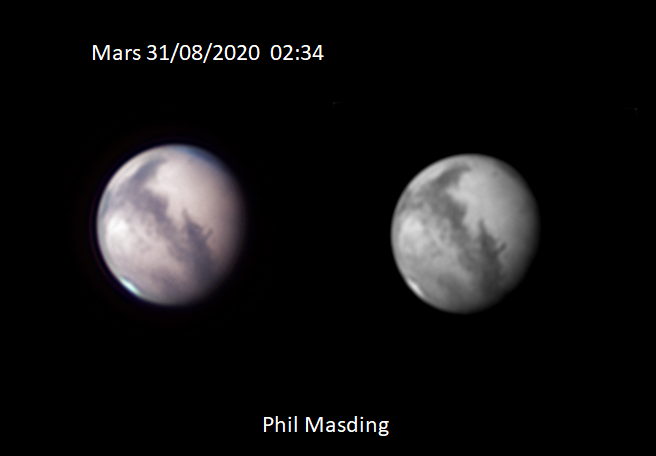
My first images of Mars for the new season. The seeing wasn’t great but at least the planet is at a decent altitude. Taken with the LX200 at f10, the ASI290MM and Baader filters.
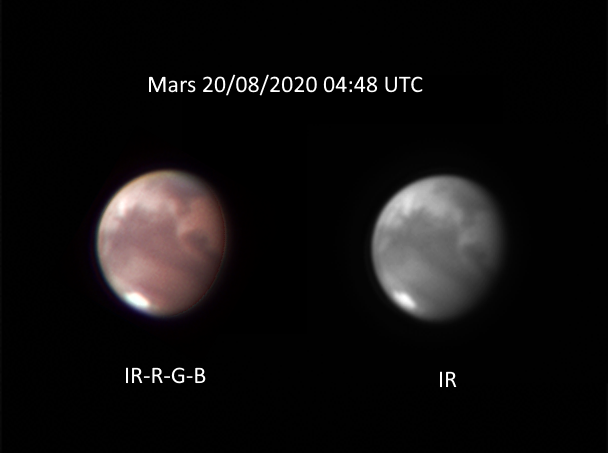
This image shows a comparison of various methods of frame selection. All images are based on the top 10% of frames according to the selection method.
- AutoStakkert 3 using 12 alignment points
- FFT using a method described here
- CNN. Using a convolutional neural net to assign a sharpness value to each frame
- Just the first 10% or 1200 frames from the video as a baseline case
All versions were then sharpened in RS6 using 30 on all wavelet sliders.
FFT doesn’t look as sharp to me but I suspect I can see a suspicious ring effect parallel to the bright limb in the others which may be an artefact.
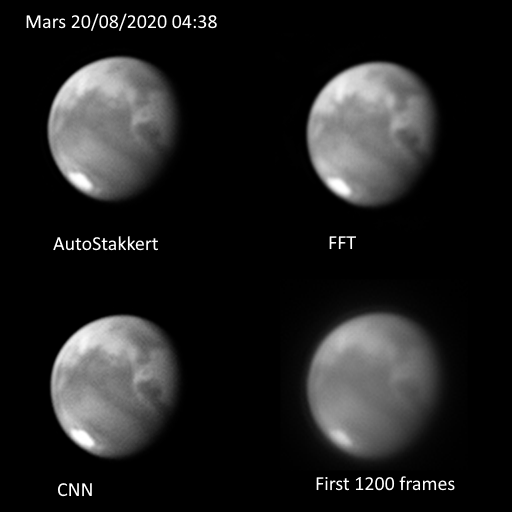
A comparison between the IR of 02:13 and a Hubble image at almost exactly the same central meridian. Olympus Mons and the Mariner Valley are well seen.
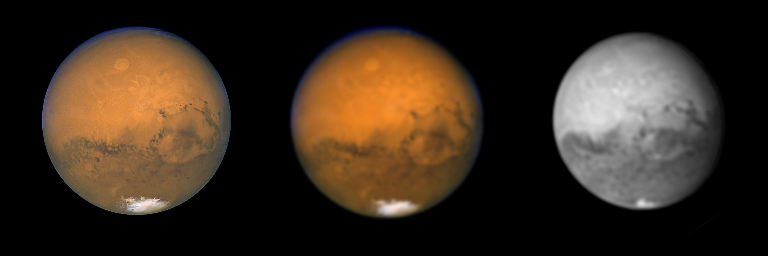
September 2018
Mars on 05/09/2018 at 21:35UTC only 11 degrees altitude. About 1/4 of the mirror couldn’t see the planet due to the observatory wall.
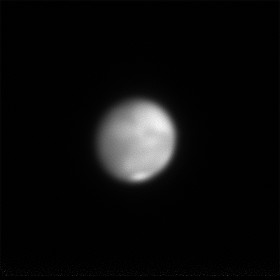
The Mars collection 2012
All images at f20 with the LX200 and the DBK camera. Opposition was on March 3 when Mars was 100 million km from the Earth and had an angular diameter of 13.9 arcsec. By May 12 The planet was 155 million km away and had shrunk to 8.9arcsec which is like looking at a penny from 460 metres away.
Jupiter
February 2025
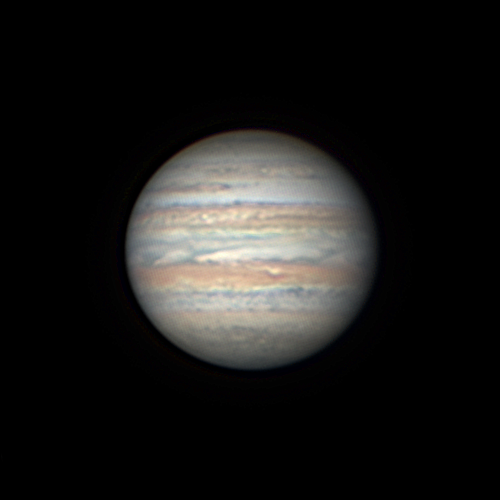
August 2022
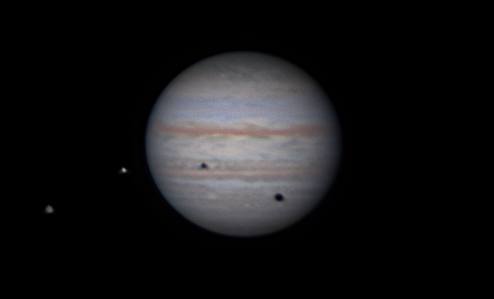
October 2021
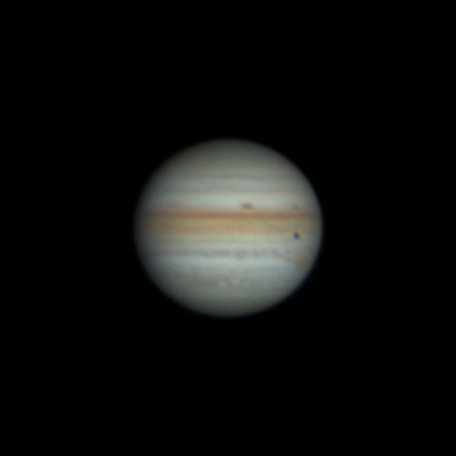
This is an IR image from 07/09/2021. ASI 290MM and LX200 at f10.
Great conjunction of 2021
The Great Conjunction of Jupiter and Saturn occurred on 21/12/2020. Here are some images from a few days before.
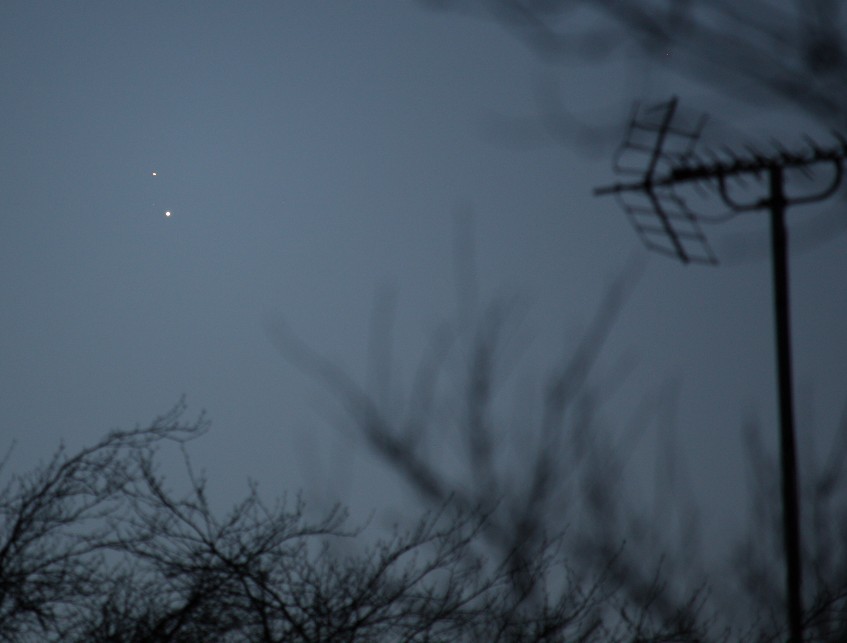
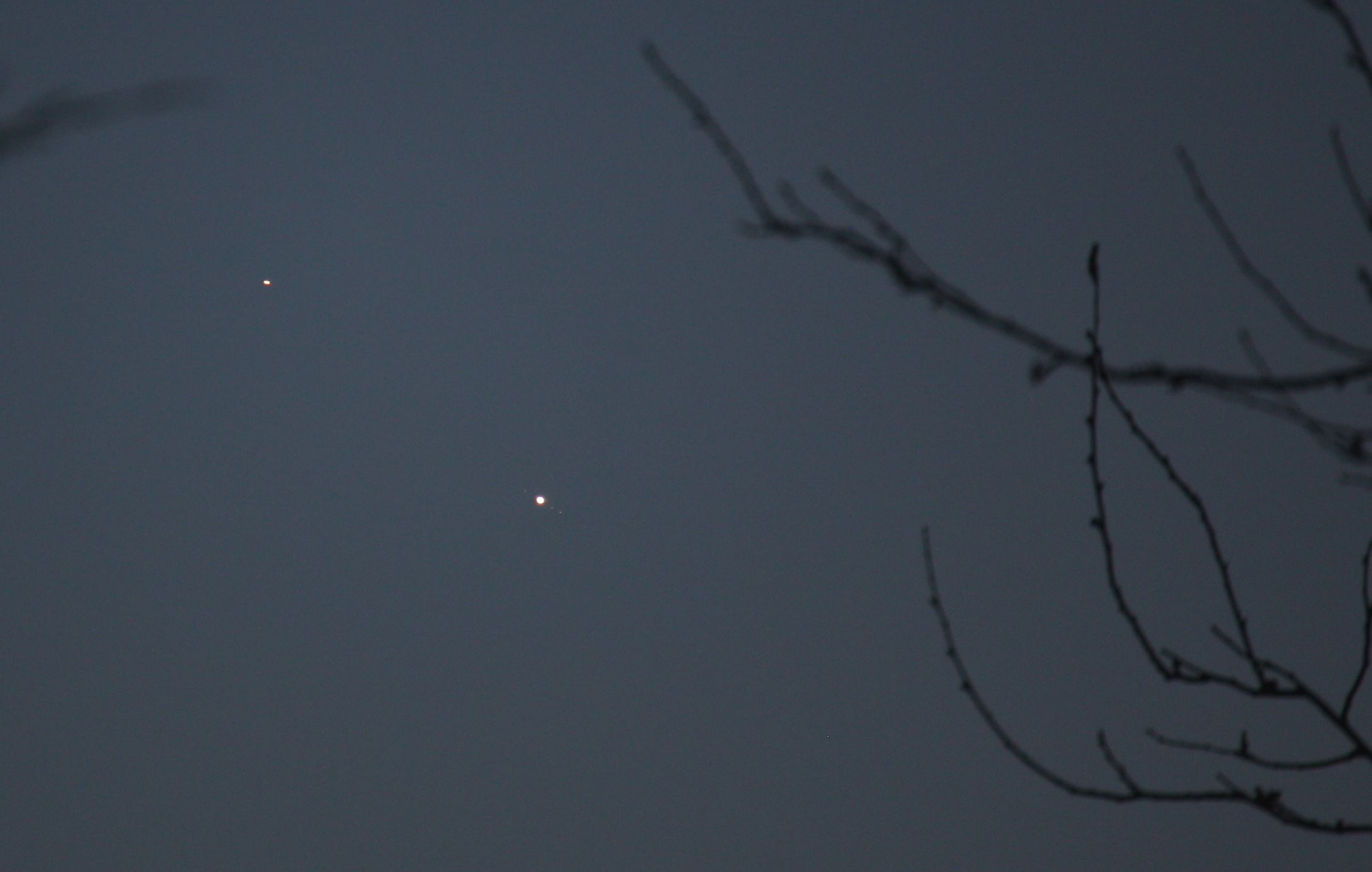
At this stage (12/12/2020) they are 1 degree apart. Canon 450D and 250mm lens, ASA400, 2 seconds. Ganymede, Europa and Callisto are visible near Jupiter.
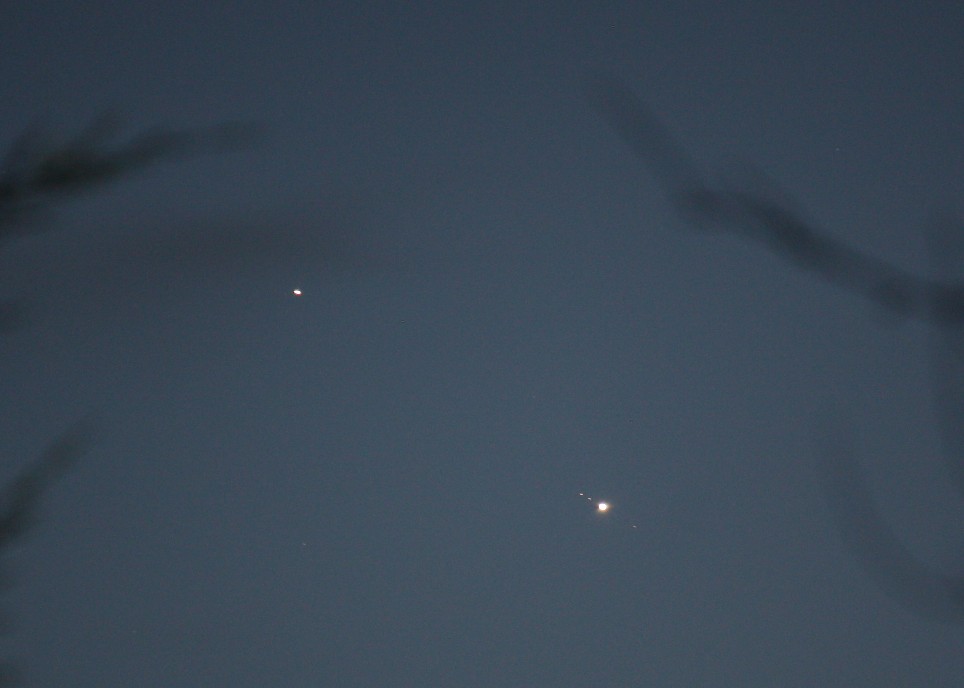
July 2018
Good seeing on 07/07/2018 resulted in the most detailed image of Jupiter this season
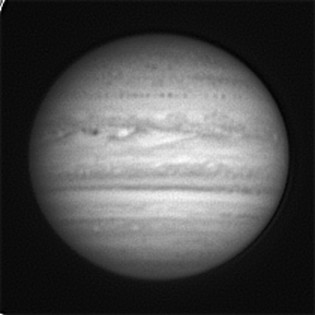
Jupiter with the IR pass filter again and some fairly good seeing. Europa is in transit and its shadow is to the left.
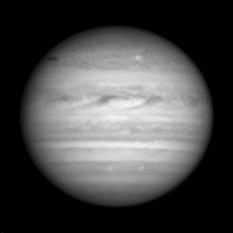
May 2017
Jupiter May 20th 2017 . Io is in transit
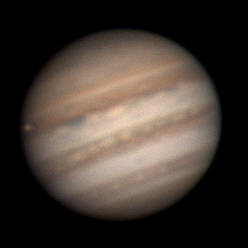
Jupiter 2016
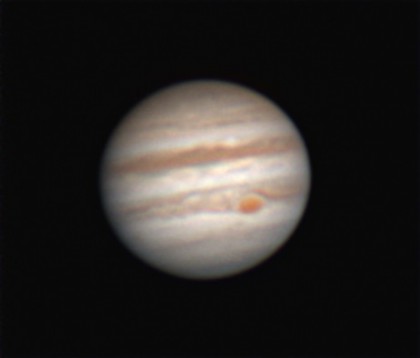
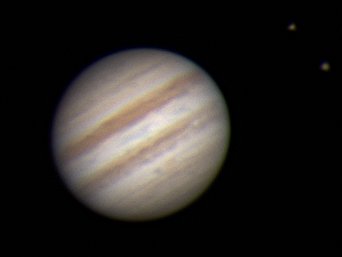
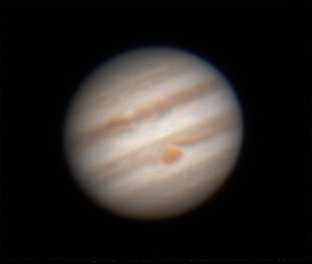
An unexpected clear night on 20/02/2014 allowed me to capture the red spot
Jupiter and Io with shadow on 18/02/2013. Times are 19:22, 19:27 and 19:49.

Tuesday 24/03/2015
Six minutes of capture processed with Autostakkert/Registax and Winjupos
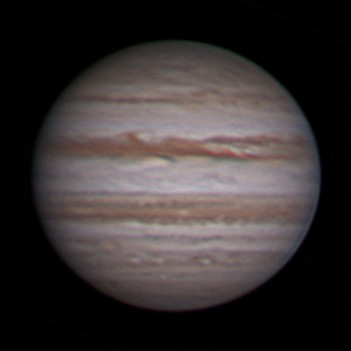
Thursday 25/12/2014
Christmas Night at 02:30 I woke up and noticed Sirius wasn’t madly twinkling like it normally does. So I just had to go and have a go at Jupiter.
Top tips from processing this with the Winjupos procedure from below. I used the right click, date modified time from the video files, these seemed to give the best auto align results in WJ. The Laptop clock seems to be spot on so must set from the net. Stacking used RS6 since Autostakkert 2.2.012 seemed to miss half the frames. The camera was on 1/30 and used Y800/unspecified. YUY2 is a non-runner. RS6 RGB balance tool is great for getting rid of a colour problem. Ganymede is to the right and Io’s shadow is on the disk. Unfortunately WJ missed Io off the final image even though it’s not far away from the planet’s limb.
Friday 07/03/2014
Experiments with Winjupos. I took 6×2 minute video clips with the DBK21AU04 and the LX200 at f20 with a 2x Orion Shorty Barlow. Winjupos procedure
- Capture 2 minute videos in IC capture using Y800 and unspecified codec. Exposure 1/30, Gain=550, Gamma=100 and brightness=100. In general I set the gain to allow an exposure of 1/30.
- Drag all videos from Windows explorer over the Start button in AutoStakkert, press analyse, on the frame view press set AP’s in the grid, press Stack.
- Stack 50% of frames and save as png files
- Process the stacks in Registax. Save the wavelet scheme after processing the first image and use the same scheme for all the others. Also use the same histogram stretch in every case. Save images as 16 bit pngs.
- Launch Winjupos program and select program/celestial body/Jupiter
- Select recording/image measurement. Enter the observatory co-ordinates +53°22’N and -2°22’W. Press the down arrow and save the observatory
- Load the first image and enter the UT time at the middle of the capture – in this case 20:43:30, 45:30, 47:30, 49:30, 51:30, 53:30
- Select the adjust tab/outline frame/automatically detect
- Adjust the outline with backspace (180 degree rotation), N, P, PgUp, PgDn, arrows
- Back to image tab and save the ims file
- Repeat for all files
- Tools/de-rotation of images/edit/select all ims files
- Compile image
- Reduce LD as appropriate so no edge effects are seen (0.97 in this case)
- Back to Registax for a bit more sharpening
Saturn
Captured at f20 with the IR pass filter
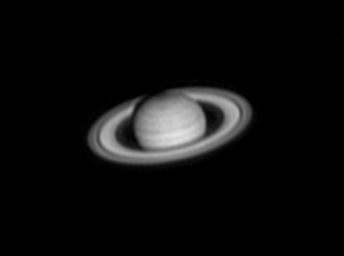
Uranus
October 2019
Uranus with the Skyris 618M, Baader 685nm IR pass filter and 10″ LX200 Classic at f20. Exposure 200ms.
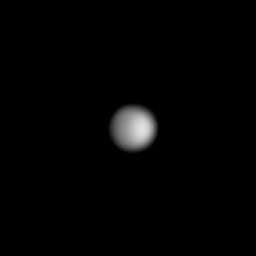
The night of Saturday 17/11/12 was completely clear. I spent some time imaging Uranus. The bright object in the centre of the Canon EOS image is Uranus and the 2 fainter objects near it are its moons Titania and Oberon. Note the terrible light pollution which gives the sky its orange colour. The moons can be seen more easily in this image with the HX516 at f10.
- I also took a spectrum using the Start Analyser which shows the methane absorption bands very clearly. Notice how the peak of the light curve is in the blue and the absorption bands are at around 550nm and 625nm.
Jupiter and Venus conjunction
Tuesday 30/06/2015 and Jupiter and Venus were 44 arcmin apart. This was close enough for this shot at f6.3 through the LX200 with the Canon 450D. This is a stack of about 16 Canon raw frames processed with Registax. Also an extremely warm evening – 22degC at 22:30.
Also with the Canon and a 55mm lens

